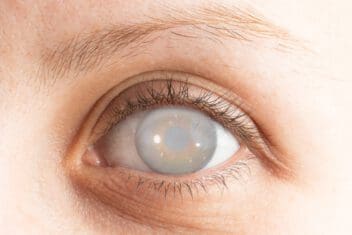Further Reading
- Guide to Medicare Coverage
- Dizzy Spells
- Cataracts & Your Golf Game
- PanOptix Trifocal Lenses (IOL)
- What Is YAG Laser Capsulotomy?
- Fast-Developing Cataracts
- Can They Cause Blindness?
- Insurance Coverage for Cataracts
- Types of Cataracts
- Stages: When to Get Treatment
- What Happens When Left Untreated?
- Do Natural Cures Work?
- Can Cataracts Come Back?
- How is Glaucoma Different?
- Identifying Cataracts
- Which Lens is Best?
- Post-Surgery Care & Tips
- Transportation Options for Cataract Surgery & Why You Can't Drive Yourself Home
Congenital Cataracts: Common Types, Prevention & Treatment Options
Last Updated:
Table of Contents
Congenital cataracts are present in newborns, clouding the lens of one or both eyes and causing early problems with vision.
Some viruses and genetic conditions increase the risk of your infant having cataracts, which can lead to trouble focusing on their surroundings, ignoring some stimuli, or rapid eye movements to focus on objects in front of them. Staying healthy during pregnancy is the only way to potentially reduce congenital cataract risk, but you cannot fully prevent this problem.
Fortunately, treatment is safe and effective. Your pediatric ophthalmologist will determine if your child’s congenital cataracts need surgery.
Key Facts About Congenital Cataracts

- Congenital cataracts are relatively rare, impacting about 4.2 births in 10,000.
- Some babies are born with congenital cataracts in both eyes. About half of these cases stem from inherited genetic defects.
- Doctors often treat congenital cataracts soon after they’re diagnosed. Babies as young as 6 weeks old can have this surgery.
- An estimated 200,000 children are blind from unoperated cataracts. Others have partial cataracts, which worsen over time and require ongoing medical treatment.
Can You Prevent Congenital Cataracts?
Some babies develop cataracts due to genetic factors parents can’t prevent or control. But sometimes, parents can make small changes and keep their babies safer as they develop.
Before Pregnancy
If you have a family history of congenital cataracts, talk with your doctor about genetic testing. Your doctor could help you understand the risks your baby faces after the birth.
Other genetic defects associated with congenital cataracts include the following:
- Congenital rubella
- Lowe syndrome
- Marinesco-Sjögren syndrome
- Conradi-Hünermann syndrome
- Down syndrome/trisomy 21
- Trisomy 13
- Galactosemia
- Hallermann-Streiff syndrome
- Chondrodysplasia syndrome
- Pierre-Robin syndrome
During Pregnancy
Work with your OBGYN to keep yourself as healthy as possible during pregnancy, which can reduce some risks like viruses.
These illnesses during pregnancy could increase your risk of baby’s risk of congenital cataracts:
- Chickenpox
- Congenital rubella
- Cytomegalovirus
- Herpes
- HIV
- Toxoplasmosis
Different Types of Congenital Cataracts?
Congenital cataracts, when present at birth, can take on several forms and variations. The most prevalent type is the lamellar cataract, but the condition is not limited to this one manifestation. It can present itself in many other forms, each with its unique characteristics and implications for vision.
| Type of Congenital Cataract | Description | Impact on Vision |
|---|---|---|
| Lamellar Cataracts | Round shape, typically 5 mm or larger. Cloudy patches can be seen in the pupil. | Usually affects both eyes and can cause significant visual impairment. |
| Nuclear Cataracts | Located in the lens’s central zone (nucleus). | May not greatly affect vision initially but can complicate visual development over time. |
| Cerulean Cataracts | Blue or white opacities appear as small dots in the lens’s peripheral region. | Often does not significantly affect vision, but regular monitoring is necessary. |
| Posterior Capsular Cataracts | Positioned at the back of the lens. | Often leads to significant visual impairment due to their location in the light’s path to the retina. |
| Polar Cataracts | Located either at the front (anterior) or back (posterior) of the lens. | Initially may not heavily impact vision but can grow over time, causing visual complications. |
| Zonular (or Zonule) Cataracts | Located in a specific zone of the lens, often appearing as a band of opacities in the lens’s peripheral region. | Impact on vision can vary based on their size and precise location. |
Please note that the specifics in this table are somewhat generalized, and actual effects may vary from individual to individual depending on multiple factors, including the severity of the cataract, the person’s overall health, and the success of treatment measures.
Congenital Cataracts in Adults
Congenital cataracts often look different than adult cataracts, which begin in late middle age and progress over decades.
After cataract surgery, there is some risk that children with congenital cataracts could develop them again later. This is typically associated with genetic disorders, requiring treatment from a pediatrician and other specialists throughout life. Your pediatric ophthalmologist will generally recommend blood tests to determine if a congenital disease is the cause of the issue.
How to Know if Your Baby Has Congenital Cataracts

The only way to know if your child has congenital cataracts is to have a pediatric ophthalmologist evaluate your baby’s eyes. If the underlying cause is a genetic disorder, working with an ophthalmologist specializing in these conditions can improve outcomes. Understanding if a genetic disorder caused congenital cataracts may require blood tests.
Symptoms of congenital cataracts can be hard to spot, although your obstetrics team should be able to identify signs such as these:
- Lack of visual awareness of the world or lack of response to visual stimuli
- Gray, white, or cloudiness in the pupil, which is normally black
- Photos of your child’s face that lack the “red eye glow,” or that glow is missing in one eye
- Nystagmus, or unusual eye movements back and forth
If your child does get congenital cataracts, removing them involves a safe, effective procedure. The diagnostic process is not invasive. Working with a pediatric ophthalmologist ensures your child will have the best possible vision.
Congenital Cataract Frequently Asked Questions
Are congenital cataracts a disability?
If the condition doesn’t pose any significant risk to the child’s vision, surgery won’t be necessary. Some minor cataracts only require ongoing monitoring.
Immediate surgical removal of the lens is usually required for infants with progressive cataracts. Even when major damage is present, surgery is only a good option if there’s reason to believe it can reverse or halt the damage. Surgery can help some people see clearly.
In some poorly resolved cataract cases, the child suffers permanent vision loss. In cases like this, it could be considered a disability.
Are congenital cataracts hereditary?
About 50 percent of childhood cataracts are associated with genetic mutations. Other issues like infections during pregnancy could cause cataracts in babies too.
Can congenital cataracts be cured in babies?
Yes. Cataract surgery can help babies see much better.
Most ophthalmologists don’t offer intraocular lens (IOL) implants to kids this young. Instead, doctors may prescribe contact lenses to correct your child’s vision after cataract surgery. The general process for the eye operation, which lasts one to two hours, is as follows:
- The surgeon uses general anesthesia to put your child to sleep before surgery.
- A clinician will use eye drops to dilate (widen) your child’s pupil(s).
- The ophthalmologist makes a tiny incision through the cornea (at the front of the eye).
- The surgeon removes the entire eye lens, which also removes the cataract.
- In older children, the doctor inserts an IOL (artificial lens).
- In younger children, the doctor sews the cornea shut with no artificial lens.
- The doctors prescribe external contact lenses or eyeglasses for your child about seven days after surgery.
The purpose of the contact lens is to enable the child to see with the treated eye. For kids under 12 months old, IOLs are avoided because they can cause future eye complications like shortsightedness.
Can congenital cataracts be cured in adults?
Yes. Your doctor can replace the damaged lens with a synthetic version so you can see clearly.
References
- Newborn With Bilateral Congenital Cataracts: Never Forget Congenital Rubella Syndrome. (March 2020). Paediatrics and Child Health.
- Congenital Cataracts. (April 2022). Nemours Foundation.
- Pediatric Cataracts: Overview. (November 2015). American Academy of Ophthalmology.
- Congenital Cataract. (September 2021). U.S. National Library of Medicine.
- Congenital Cataract: Morphology and Management. (September 2013). Pakistan Journal of Ophthalmology.
- Pediatric Cataracts. American Academy of Ophthalmology.
The information provided on this page should not be used in place of information provided by a doctor or specialist. To learn more, read our Privacy Policy and Editorial Policy pages.
Further Reading
- Guide to Medicare Coverage
- Dizzy Spells
- Cataracts & Your Golf Game
- PanOptix Trifocal Lenses (IOL)
- What Is YAG Laser Capsulotomy?
- Fast-Developing Cataracts
- Can They Cause Blindness?
- Insurance Coverage for Cataracts
- Types of Cataracts
- Stages: When to Get Treatment
- What Happens When Left Untreated?
- Do Natural Cures Work?
- Can Cataracts Come Back?
- How is Glaucoma Different?
- Identifying Cataracts
- Which Lens is Best?
- Post-Surgery Care & Tips
- Transportation Options for Cataract Surgery & Why You Can't Drive Yourself Home